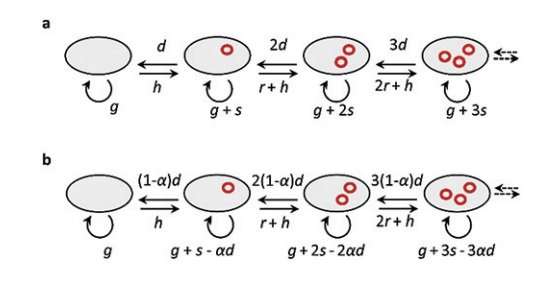July 27, 2018 feature
How did genetic parasites overcome natural selection for billions of years?

Nearly half of the human genome is composed of genetic parasites—transposons, plasmids, viruses, and other genetic elements that have one thing in common: they don't make any beneficial contributions to their hosts, and can sometimes have harmful effects. Genetic parasites—sometimes called "selfish genes"—originated early in the history of life and today are present in nearly all living organisms.
The discovery that genetic parasites are so ubiquitous and abundant is one of the many surprising findings in the field of genomics, but many questions remain unanswered. One of the most basic questions is simply how genetic parasites have managed to persist for so long, despite the evidence that they are harmful at evolutionary timescales. Typically, natural selection results in deletions of harmful genes, so the main question is, why hasn't natural selection wiped out genetic parasites?
In a new study published in EPL, researchers Jaime Iranzo and Eugene V. Koonin at the National Institutes of Health in Bethesda, Maryland, have found that horizontal gene transfer may be one of the keys to understanding the persistence and spread of genetic parasites over evolutionary timescales.
In horizontal gene transfer (HGT), genetic information is transferred to an organism by a variety of mechanisms other than the traditional parent-to-offspring process of transferring DNA. For example, an organism may receive genetic material directly from another organism—even one of a different species—or pick up genetic material from the surrounding environment. For genetic parasites, HGT offers a way to infect new hosts, providing a potential mechanism to compensate for the losses due to natural selection.
Early studies have shown, however, that it's unlikely that HGT alone could enable genetic parasites to persist for long periods of time, assuming typical HGT rates. Later research suggested that random fluctuations in the HGT rates might allow for the persistence of some genetic parasites.
Now in the new study, the researchers analyzed large amounts of data on the spread of genetic parasites in microbial populations, and used it to estimate the minimum HGT transfer rates required for the long-term survival of genetic parasites. The analysis involved using mathematical modelling and comparative genomics to quantify the effects of various factors on the spread and persistence of genetic parasites.
The researchers found that, although the critical HGT rate depends on the strength of natural selection and the rate of gene deletion, the typical HGT rates of genetic parasites are generally high enough to guarantee their long-term survival. The findings provide evidence that genetic parasites may use HGT to overcome natural selection and persist in their hosts' genomes for billions of years. Their results also help explain why different types of genetic parasites use different strategies.
"By quantifying the cost of genetic parasites and the minimum HGT rate that parasites require to persist, we gained a fundamental understanding of why selfish genes differ in their parasitic strategies," Iranzo told Phys.org. "For example, genetic parasites that are very deleterious need very high HGT rates, which can only be achieved by evolving autonomous mechanisms for HGT (the case of viruses and conjugative plasmids) or by piggybacking on another parasite that is autonomous for HGT (the case of toxin-antitoxin modules). Mild genetic parasites, such as transposons, have more options, such as evolving mechanisms that allow them to proliferate within their host genomes."
Although genetic parasites do not provide any functional benefits to their hosts, the competition between early living organisms and genetic parasites may have played a vital role in some of the major evolutionary events in the history of living organisms. For example, this competition may have been one of the driving forces behind cell compartmentalization as well as the origin of multicellular life forms, and may have also made living organisms more resistant to other parasite invasions. Understanding the persistence of genetic parasites has implications for understanding these events, as well as to help answer other questions.
"A natural extension of our work is to study the interactions among different classes of genetic parasites," Iranzo said. "How does the presence of a genetic parasite affect the long- (and short-) term survival of other genetic parasites? What ecological and evolutionary factors promote cooperation and/or competition among genetic parasites? A second focus would be capturing the transient dynamics observed at the scale of multiple populations and species, where genetic parasites seem to be proliferating in some species and declining in others."
More information: Jaime Iranzo and Eugene V. Koonin. "How genetic parasites persist despite the purge of natural selection." EPL. DOI: 10.1209/0295-5075/122/58001
Journal information: Europhysics Letters (EPL)
© 2018 Phys.org



















